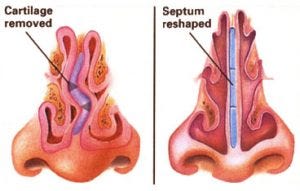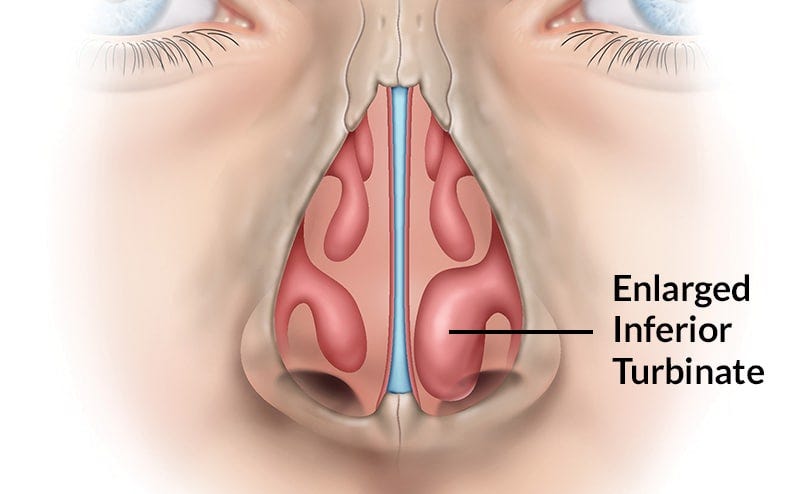Surgeon's Guide: Septoplasty and Turbinate Reduction
How Nasal Surgery Can Improve Quality of Life and Sleep Health
Let’s talk about the nose. Nasal obstruction can contribute significantly to poor sleep, snoring, and worse sleep apnea outcomes. As sleep apnea surgeons, often the first thing we are looking to improve is nasal breathing- thankfully, the surgery to do so is straight-forward, has high patient success, and is typically a much easier recovery than our other sleep apnea procedures.
In this post, we will review nasal septoplasty and turbinate reduction. We’ll walk through what the procedures are, review the academic literature and our experience of the benefits they offer, and discuss what patients can expect.
The Basics: What Are Septoplasty and Turbinate Reduction?
Septoplasty is a procedure to correct a deviated nasal septum—the wall of cartilage and bone that separates your left and right nasal passages. When the septum is crooked, it can block airflow through one or both nostrils. The surgery acts to straighten and thin the septum.
Turbinate reduction addresses the other common cause of nasal congestion: enlarged inferior turbinates. These are structures on the inside of your nose that warm and humidify air as you breathe. When they’re too large, due to allergies or chronic inflammation, they can significantly obstruct airflow. The reduction acts to make them smaller.
Both surgeries aim to create a clearer, more open nasal passage to support effortless nasal breathing—day and night.
Evidence Summary: Nasal Breathing and Sleep
The academic literature strongly supports nasal surgery as a means to improve daytime and nighttime quality of life. I (CG) tell patients that it is a great starting place to improve sleep, get the best trial of cpap, and optimize daytime nasal function.
1. Nasal Surgery and Sleep Quality
Nasal obstruction contributes to poor sleep quality and fragmented sleep, even in the absence of obstructive sleep apnea (OSA). Improving nasal airflow via surgery has been shown to enhance subjective sleep quality and improve daytime function.
Stapleton et al., Otolaryngology Head Neck Surg. 2014
2. Nasal Surgery and Obstructive Sleep Apnea (OSA)
Nasal surgery alone does not “cure” OSA, but can lead to reductions in AHI and improve tolerance of CPAP.
Camacho et al., Sleep. 2015
3. Nasal Surgery and Quality of Life Improvement
Nasal surgery consistently improves nasal-specific quality of life, as measured by standard research tools.
Valsamidis et al., Int Arch Otorhinolaryngol. 2018
What to Expect: The Surgery and Recovery
Septoplasty and turbinate reduction is an outpatient procedure done under general anesthesia. The surgery usually takes less than an hour, and there are no external incisions.
Recovery timeline:
Day 1–4: Congestion, pressure, drainage, fatigue, and headaches are very common.*
Day 5–7: Breathing starts to improve; fatigue fades; almost back to normal by week end.
2 weeks: Most patients are back to full activity and breathing much better through their nose.
*A few things to know:
Septal splints are typically kept in the nose for first 3-5 days. Pain and congestion get DRAMATICALLY better after they’re removed.
Some congestion is normal in early healing, but significant improvements in airflow are typically noticed immediately upon splint removal.
Who Benefits Most?
Ideal candidates:
People with chronic nasal obstruction affecting them during daytime and/or night
Those with CPAP intolerance related to mask fit or airflow resistance
Individuals with visibly crooked septum and turbinate hypertrophy
We always evaluate with nasal endoscopy in clinic.
Bottom Line: Small Surgeries, Big Impact
Septoplasty and turbinate reduction are among the most common surgeries I (CG) perform—and they deliver some of the biggest improvements in quality of life: people often notice better sleep, decreased snoring, and easier breathing during exercise
If you or someone you know suffers from chronic nasal congestion, it’s worth a visit to an ENT specialist. The nose matters more than we give it credit for—especially when it comes to sleep.
Thanks for reading,
Chris & Robson






